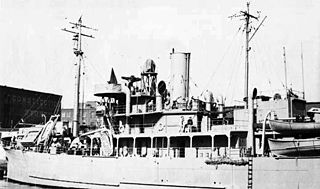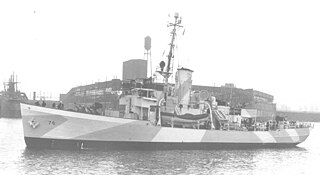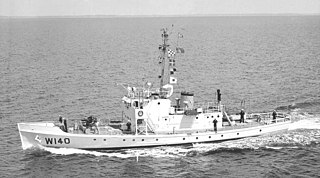
USS Ellyson (DD-454/DMS-19), a Gleaves-class destroyer, is the only ship of the United States Navy to be named for Theodore Gordon Ellyson, a submariner who became the first officer of the U.S. Navy to be designated a naval aviator.

USCGC Triton (WPC-116), a steel-hulled, diesel-powered Thetis-class patrol boat of the United States Coast Guard, was the fourth commissioned ship of the United States to be named for Triton, a Greek demigod of the sea who was the son of Poseidon and Amphitrite. She served almost simultaneously with the submarine of the same name. Today, she serves as a tour boat in New York City for Circle Line Sightseeing Cruises, and carries the name Circle Line XVII.

USS Jacob Jones (DD-130), named for Commodore Jacob Jones USN (1768–1850), was a Wickes-class destroyer. Jacob Jones was laid down by the New York Shipbuilding Corporation at Camden, New Jersey on 21 February 1918, launched on 20 November 1918 by Mrs. Cazenove Doughton, great-granddaughter of Commodore Jones and commissioned on 20 October 1919, Lieutenant Commander Paul H. Bastedo in command. She was sunk by a German submarine in 1942 during World War II.

USS Schenck (DD-159) was a Wickes-class destroyer in the United States Navy during World War II. She was named for Rear Admiral James F. Schenck, USN (1807–1882).

The second USS Absecon (AVP-23) was a United States Navy Barnegat-class seaplane tender in commission from 1943 to 1947, converted during construction to serve as a catapult training ship during World War II. The ship was in commission in the United States Coast Guard as the cutter USCGC Absecon (WAVP-374), later WHEC-374, from 1949 to 1972. Transferred to South Vietnam in 1972, she served in the Republic of Vietnam Navy as the frigate RVNS Pham Ngu Lao (HQ-15) until she was captured by North Vietnam at the conclusion of the Vietnam War in 1975. After that, she served in the Socialist Republic of Vietnam's Vietnam People's Navy as PRVSN Pham Ngu Lao (HQ-01).

USS Upshur (DD–144) was a Wickes-class destroyer in the United States Navy before and during World War II. She was the first ship named for Rear Admiral John Henry Upshur.

Naval Station Argentia is a former base of the United States Navy that operated from 1941 to 1994. It was established in the community of Argentia in what was then the Dominion of Newfoundland, which later became the tenth Canadian province, Newfoundland and Labrador.

The USCGC Evergreen was a Cactus-class seagoing buoy tender operated by the United States Coast Guard. She served in the North Atlantic during World War II and participated in the International Ice Patrol in these waters after the war. She was the first dedicated oceanographic vessel in the Coast Guard's history. She was decommissioned in 1990 and sunk by the US Navy for target practice in 1992.

The third USS Casco (AVP-12) was a United States Navy Barnegat-class small seaplane tender in commission from 1941 to 1947. She saw service in World War II. After her decommissioning, the U.S. Navy loaned her to the United States Coast Guard, in which she served as the cutter USCGC Casco (WAVP-370), later WHEC-370, from 1949 to 1969.

USCGC Cuyahoga (WIX-157) was an Active-class patrol boat built in 1927 which saw action in World War II. Cuyahoga sank after a night-time collision in the Chesapeake Bay while on patrol in 1978. She was later raised and re-sunk as an artificial reef off the Virginia coast and is a popular recreational dive site.

USCGC Mendota (WHEC-69) was an Owasco class high endurance cutter built for World War II service with the United States Coast Guard. The ship was commissioned three months before the end of the war and did not see combat action until the Vietnam war.

USCGC Seneca, or before 1915 USRC Seneca, was a United States Coast Guard cutter built and commissioned as a "derelict destroyer" with the specific mission of locating and then destroying abandoned shipwrecks that were still afloat and were a menace to navigation. She was designed with excellent sea-keeping qualities, a long cruising range, good towing capabilities, and by necessity the capacity to store a large amount of munitions. She was one of five Coast Guard cutters serving with the U.S. Navy in European waters during World War I.

USS Manhasset (AG-47/YAG-8) – later known as USCGC Manhasset (WIX-276) – was a commercial cargo ship leased by the U.S. Navy during World War II. She was armed with guns and depth charges and was used as a weather patrol ship, a convoy escort, and as a patrol craft. She experienced action in the dangerous North Atlantic Ocean, but returned home safely after war's end.

USS Matagorda (AVP-22/AG-122) was a United States Navy Barnegat-class seaplane tender in commission from 1941 to 1946 that saw service in World War II. After the war, she was in commission in the United States Coast Guard as the cutter USCGC Matagorda (WAVP-373), later WHEC-373, from 1949 to 1967.

USCGC Tampa was a United States Coast Guard Cutter that served in the United States Coast Guard from 1921 to 1941, and then in the United States Navy from 1941 to 1947.

USCGC Comanche (WPG-76) was a United States Coast Guard cutter built by Pusey & Jones Corporation, Wilmington, Delaware, and launched 6 September 1934. She was commissioned on 1 December 1934. She was used extensively during World War II for convoy operations to Greenland and as a part of the Greenland Patrol.
USCGC Clover WAGL/WLB/WMEC-292, a Cactus (A) Class buoy tender was built by Marine Iron and Shipbuilding, Duluth, Minnesota. Her keel was laid 3 December 1941, and she was launched 25 April 1942. She was commissioned on 8 November 1942 in the United States Coast Guard as the United States Coast Guard Cutter Clover. She was built as a WAGL, redesignated a WLB in 1965, and again redesignated a WMEC in 1979.

The Greenland Patrol was a United States Coast Guard operation during World War II. The patrol was formed to support the U.S. Army building aerodrome facilities in Greenland for ferrying aircraft to the British Isles, and to defend Greenland with special attention to preventing German operations in the northeast. Coast Guard cutters were assisted by aircraft and dog sled teams patrolling the Greenland coast for Axis military activities. The patrol escorted Allied shipping to and from Greenland, built navigation and communication facilities, and provided rescue and weather ship services in the area from 1941 through 1945.

USCGC Legare (WSC-144) was cutter that served in the United States Coast Guard for almost forty-one years.

USCGC McLane (WSC-146) was a 125 ft (38 m) United States Coast Guard Active-class patrol boat in commission from 1927 to 1971. She was named for Louis McLane, (1786–1857) who was appointed in 1833 as United States Secretary of State. In May 1966, she was redesignated as (WMEC-146).


















